Course Numbers & Descriptions
Please use the expand and collapse blocks below to link to classes by program and topic area.
We invite you to browse all the offerings and let us know if you have any questions. For individual courses, please reach out to the professor. For other questions about your major, minor, or our curriculum more generally, please contact your major advisor or any of us listed below. Department faculty and staff are happy to answer your questions and discuss your options by email or appointment.
Department Chair and Director of Undergraduate Studies in Art History – Prof. Ian Bourland
Director of Undergraduate Studies in Studio Art – Prof. Scott Hutchison
Director of MA Program in Art and Museum Studies – Prof. Lisa Strong
Department Administrator — Prof. Andrea Gallelli Huezo
Department and Graduate Program Coordinator – Em Aufuldish
Please use the expand and collapse blocks below to link to classes by program and topic area.
Perspective Drawing by Spencer Paik
Still Life Drawing by Leah Nishiguchi
Demo by Marisa
ARTS 1100-01 – Drawing I This course will address the basic technical components of making a work of art through drawing. All levels of experience are welcome, and I will work with each student individually to ensure growth and improvement. We will begin the course working directly from still life and then move to more complex projects (figure, portrait) as the semester continues. Exploration, interpretation, and experimentation are encouraged! Students will build a drawing vocabulary and examine a variety of drawing philosophies that will transcend this course and assist them with the entire experience of making any type of art.
This course is taught by Professor Marisa Stratton.
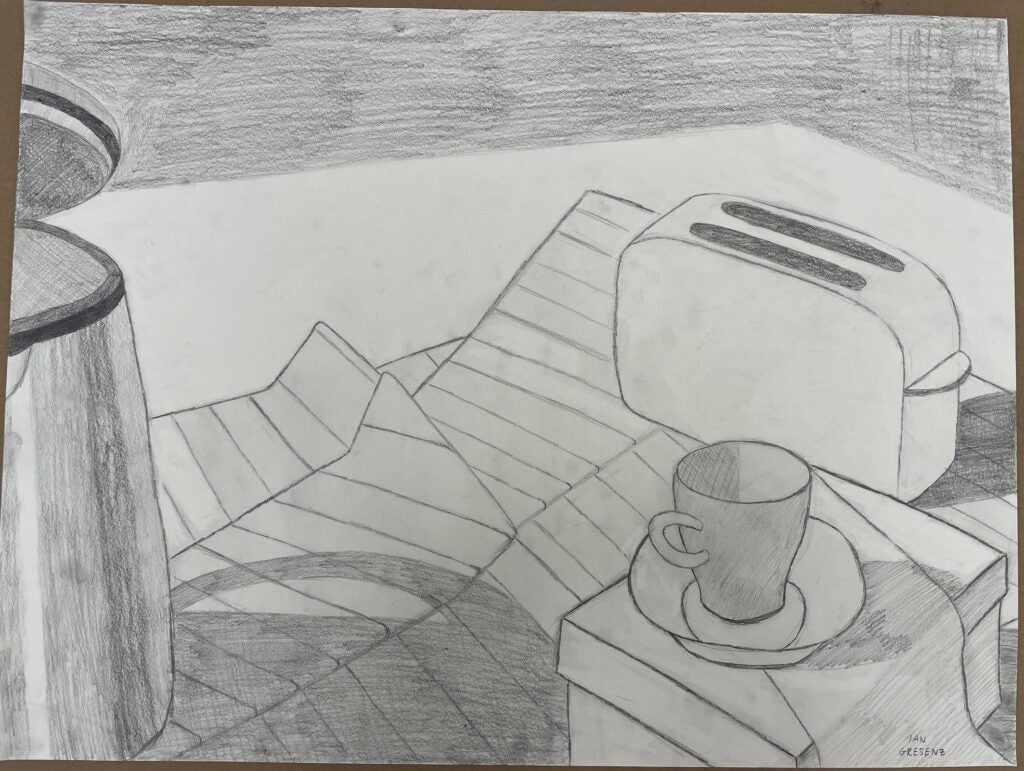
Ian Gresenz, Still life composition

Julian Huang, Drawing on black paper

Fiona Howard, Figure study
ARTS 1100-02, -05 – Drawing I This course is dedicated to providing a full studio drawing experience. Emphasis is on drawing what you see. Beginning with how to hold a pencil, demonstrations will be given as we draw various objects, spaces, and figure models from observation. A variety of materials such as pencil, conté, charcoal, ink, and color pastel will be used. I will support everyone in the process of building a drawing ultimately in their preferred style.
This course is taught by Professor Ji Yu.
Peris Lopez, Profile Portrait Drawing
Anastasia Wass, Drawing Glass
Julia Gigante, High Contrast Drawing
ARTS 1100-03 – Drawing I: Visual Language Gustav Klimt once said, “Art is a line around your thoughts.” In this course, students will use drawing as a means of creative reflection and as a means to process the world around them. Students will draw inspiration for their work from their personal-history and surrounding environments. They will learn to see the world from a new perspective, and with fresh eyes. This course will begin with foundational material, building step by step in complexity. Students will use checklists to help them to develop and fix line drawing, shading, and composition. Understanding that students have different levels of drawing experience, I work with each student individually to help them improve. Using interactive group critiques and one-on-one feedback from me, all students will gain valuable feedback on their drawings. A variety of drawing processes and techniques will be covered. Subjects covered will include still life, landscape, portraiture, the figure, and architectural perspective drawing.
ARTS 1100-03 is taught by Professor Scott Hutchison.
Jenna Royson, Reflections
Kent Hall, Flower study
Jade Murphy, Ballet Slippers
ARTS 1100-04 – Drawing I In this course, students explore drawing as a graphic means to process the world around them. The class starts with the fundamentals of composition, and how to use light and shadow to describe form. We then look at line as a means of discovery and expression, along with other techniques of rendering form, space and texture. Projects range from still life and interiors to studies of nature, animal skulls and the portrait/figure. Students are approached on an individual basis as well as through group discussions, slideshows, demonstrations and critiques. “Learning to draw is really a matter of learning to see.” – Kimon Nicolaides.
This course is taught by Professor Nataliya Gurshman.

Student hand study

Student tooth study

Student old master copy
ARTS 2100-01 — Drawing II: Figure This painting course is focused on figurative drawing with the use of various media and techniques with the explicit aim to hone each student’s ability to render the human form with greater ease and accuracy. This class involves learning the complexities of life studies, drawing directly from a model for most class sessions. All formal and compositional concerns will be considered and are an essential aspect of the course. The students will be introduced to both traditional and contemporary figurative artists through lectures and museum visits and Old Master Copies. There is an emphasis on primarily traditional approaches to drawing to form a solid foundation upon which to build any further figure studies. As such, it is expected that the drawings made for this class aim to be in the realm of Realism. This course takes a more classical and comprehensive approach to drawing, starting with proportions and expressive line studies and culminating in the trois crayon technique and the like. The goals of the course are to teach classic techniques of figurative drawing in incremental steps that will allow students to build confidence in their work. Students will gain from their observation and consistent life renderings, a better ability to map and execute whatever they desire.
This course is taught by Professor Erik Sandberg.

Linocut by student Grace Nguyen.

Linocut self-portrait by student Tyler McConville.
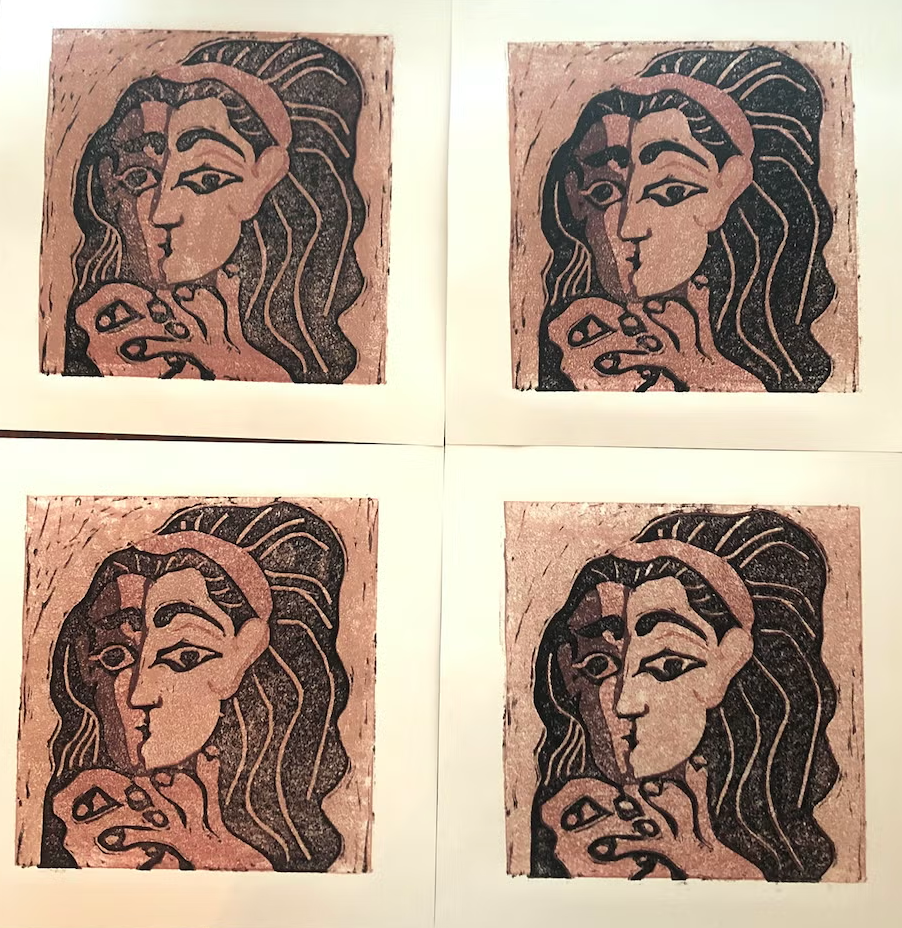
Linocut by student Grace Nguyen.
ARTS 1201-01 – Printmaking I: Intaglio This course utilizes traditional hand printing of relief images from Linoleum plates. Test plates are done in color and in black and white. Folds and simple bookmaking are presented as options. After learning safe cutting, registration and printing methods, students are encouraged to pursue their own personal imagery. Critiques and view and response of videos and online print-related sites is required.
This course is taught by Professor Scip Barnhart.

Book by student Olivia Tatarian

Book by student Jordyn Jones
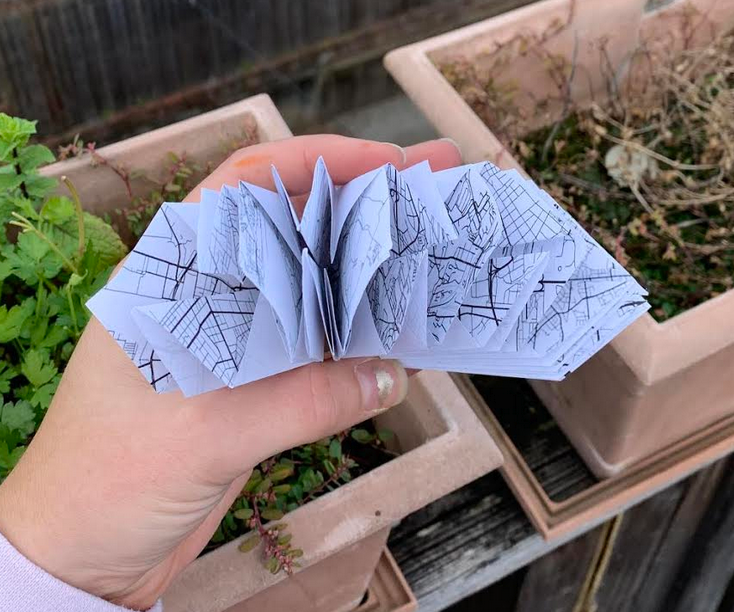
Book by student Olivia Tatarian
ARTS 1603-01 — Art of the Book This course explores the practice and creation of unique artist books. Multiple bindings, sewing, folds, cutting methods, and techniques are taught to prepare students for personal expression through handmade books.
This course is taught by Professor Scip Barnhart.

Long Depth of Field, by student Natalie Sanders.

Long Depth of Field, by student Valerie Sanchez.
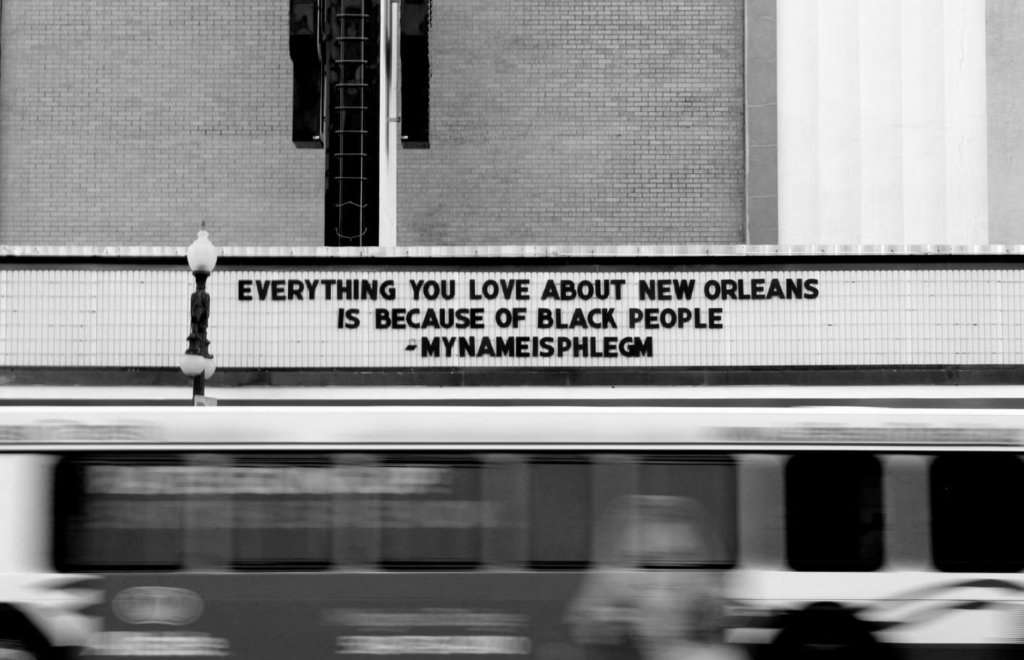
Motion Blur, by student Leo Arnett.
ARTS 1301-01 – Photo I: Digital A basic digital photography studio art course designed to develop the hands-on skills necessary to produce and identify the elements of a good photograph and to acquire a thorough working knowledge of digital equipment. Students will gain an understanding of the aesthetic and technical areas of photography as fine art. Class lectures, discussions, and digital assignments will deal with photographic composition, criticism, and history. Fundamental knowledge of computer programs such as Photoshop will be introduced in the semester to develop photographic imagery.
This course is taught by Professor Kelly Carr.
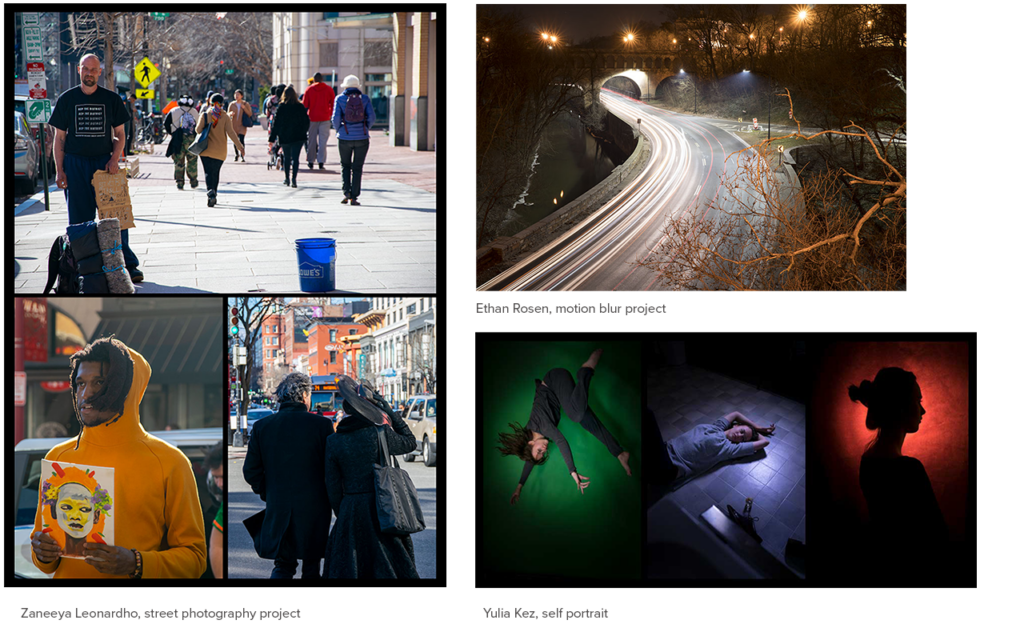
ARTS 1301-02 — Photo I: Digital This is an introductory digital photography studio art course designed to develop the hands-on skills necessary to produce and identify the elements of a good photograph and to acquire a thorough working knowledge of digital equipment. Students will gain an understanding of the aesthetic and technical areas of photography as a fine art. Class lectures, discussions and digital lab assignments will deal with photographic composition, criticism and history, camera and paper types, and printer systems. Fundamental knowledge of computer programs such as Photoshop will be covered for students to edit and print their work. Students enrolled in studio courses must devote a minimum of 4 to 6 hours per week outside of class to develop and complete assignments. Through the analysis of the history of this medium this class involves the study of photography as a metaphor for the human condition with students engaging in self-reflection and questioning through analysis, inquiry, dialogue and creation.
This course is taught by Professor Roberto Bocci.
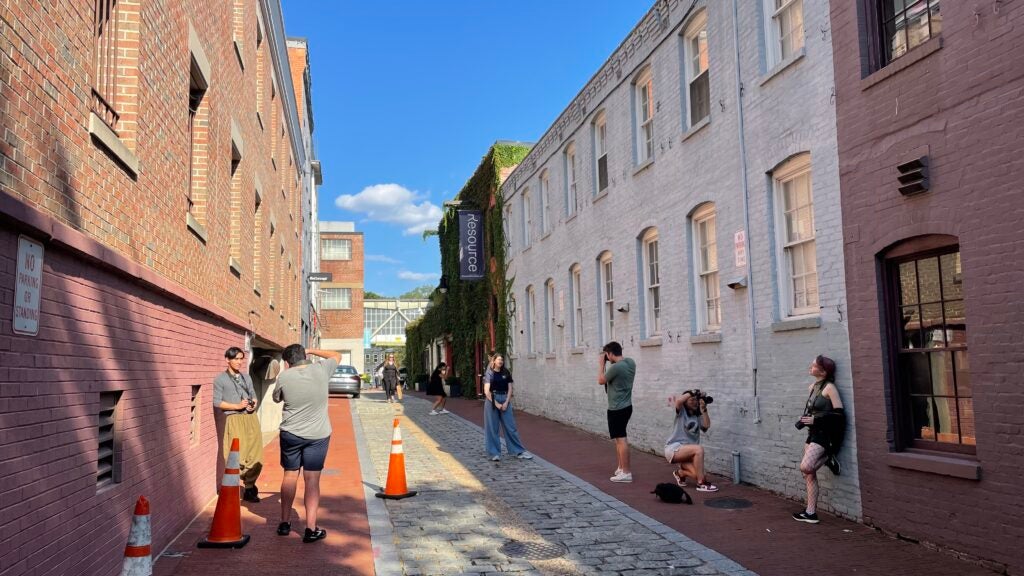
Georgetown University photography students taking photographs on location in Georgetown.
ARTS 1301-04 – Photo I: Digital This is an introductory digital photography studio art course designed to develop the hands-on skills necessary to produce and identify the elements of a good photograph and to acquire a thorough working knowledge of digital equipment. Students will gain an understanding of the aesthetic and technical areas of photography as a fine art. Class lectures, discussions, and digital lab assignments will deal with photographic composition, criticism and history, camera and paper types, and printer systems. Fundamental knowledge of computer programs such as Photoshop will be covered for students to edit and print their work. Students enrolled in studio courses must devote a minimum of 4 to 6 hours per week outside of class to develop and complete assignments. Through the analysis of the history of this medium, this class involves the study of photography as a metaphor for the human condition with students engaging in self-reflection and questioning through analysis, inquiry, dialogue, and creation. This course fulfills the Georgetown HALC (Humanities, Art, Literature, and Culture requirement) requirement.
This course is taught by Professor Brady Robinson.

Ashley Mayhall, DSLR Pinhole Camera
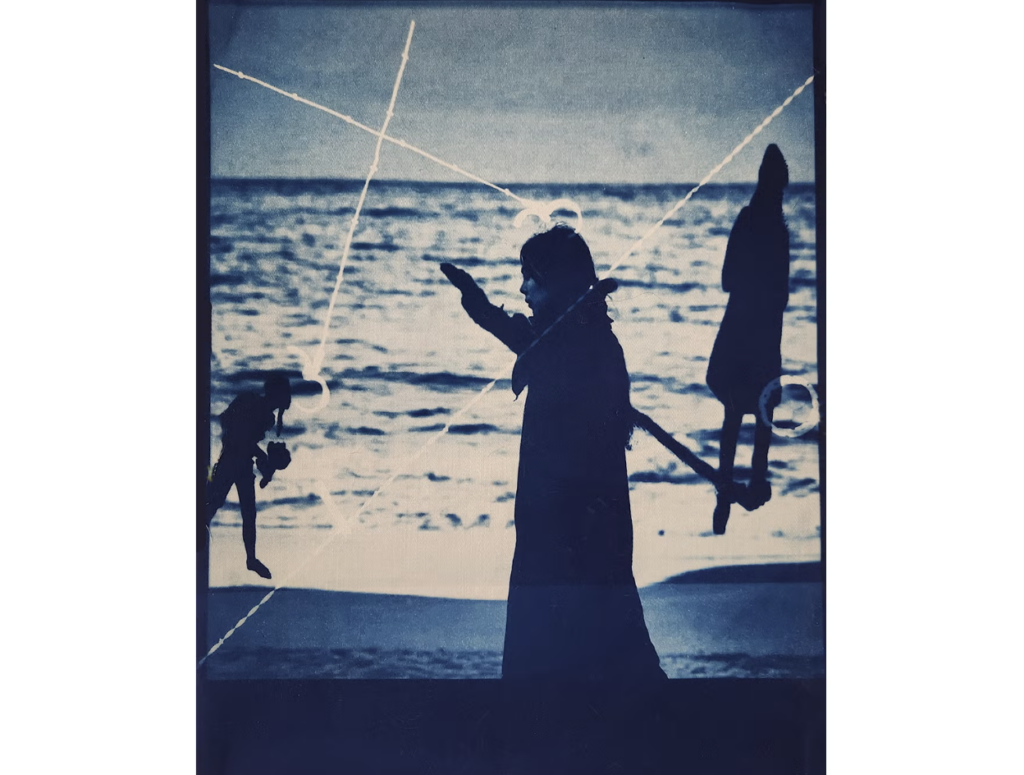
Jingyi Tang; Cyanotype

Katie Watke; Camera Obscura
ARTS 1302-01 — Photo I: Alternative Processes Back in the day meets modern day, contemporary alternative photographic processes. This class combines modern day technology with historic non-traditional printing and photographic processes. DSLR cameras and photo editing software are applied to centuries old photographic processes. Students will gain knowledge of both digital and hands-on non-traditional processes. Additionally, the class will include discussions as to history, invention, and contemporary artist regarding each process.
This course is taught by Professor Kelly Carr.

Nancy Burson project, by student Pedro Ramirez

Booklet Project, by student Paul Rockford.
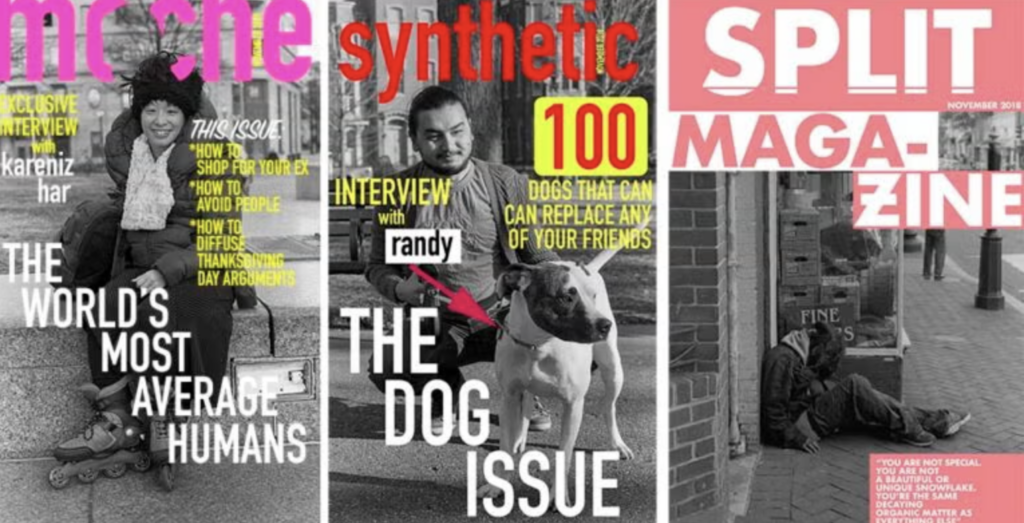
Text-to-Image project, by student Henry Smithers
ARTS 2300-01 – Photo II is an advanced class for both film and digital photography students to continue shooting and printing their creative work in order to compile a portfolio that can be used to apply for internships, jobs or graduate school. Projects include the portrayal of a city (Washington DC and/or other), event documentation (the documentation of street events, political protests, rock concerts etc.), a book-making project that can be printed and bound in-house or sent out to companies like Blurb, and mini projects to learn how to use advanced Photoshop compositing and editing techniques. Projects can be developed on film or digital format and printed as gelatin silver and/or digital prints. As students produce work the prints are inserted into a hard copy portfolio or added to a website. The primary software packages you will use are Adobe Photoshop and Bridge and/or Adobe Lightroom.
This course is taught by Professor Roberto Bocci.

Sidney Lee, Modeling from life

Sean Letendre, Cardboard self-portrait
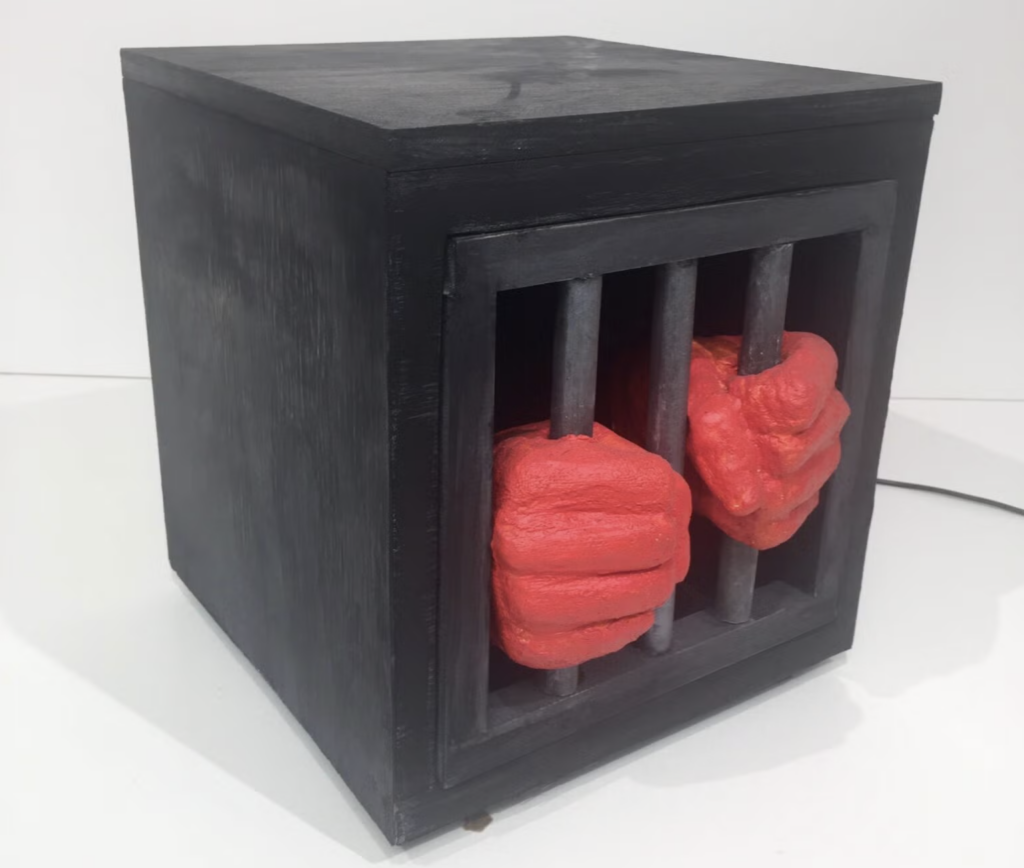
Corine Forward, Spring 2019, Micro Monument Assignment
ARTS 1400-01 & 1400-02 – Sculpture I Sculpture I offers students the opportunity to exercise their creative drive through making three-dimensional form. Students work in traditional and contemporary methods and materials. During the semester there are three thematically driven projects that simultaneously introduce new materials, processes, and conceptual consideration. The semester will include projects that range from modeling a form in clay, creating sculptures with recycled cardboard, and using found objects to construct a sculpture. This course is designed for the novice sculptor and assignments emphasize foundational skills.
Please note that the Sculpture Studio is located in the basement of the Walsh building, down one flight of stairs. This room is not wheelchair accessible.
Both sections of ARTS 1400 are taught by Professor Evan Reed.

Still Life by Allie Stevens

Trompe L’oeil Still Life by Nicole Keller
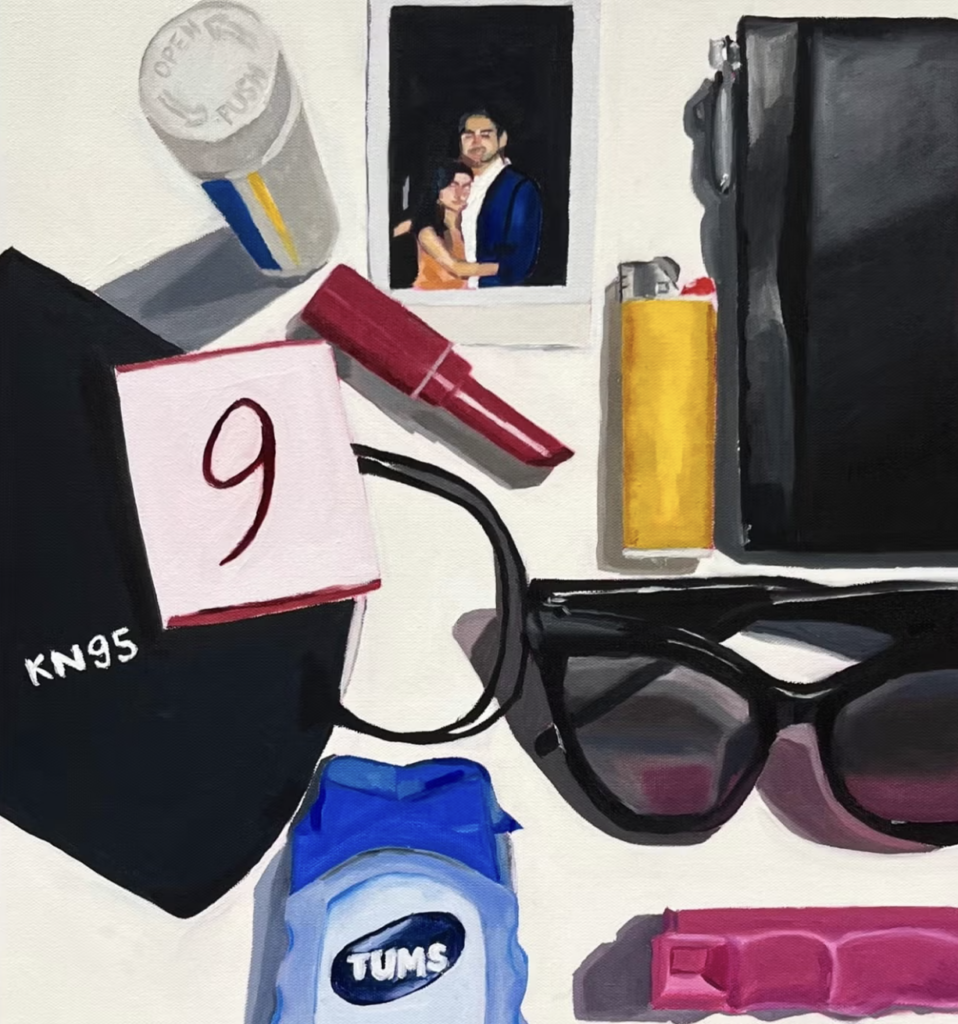
Trompe L’oeil Still Life by Kayla Zamanian
ARTS 1500-01 — Painting I: Oil This course will address the basic components of making a work of art through oil painting. All levels of experience are welcome, and I will work with each student individually to ensure growth and improvement. We will begin the course working directly from still life and then move to more complex projects as the semester continues. The course will provide historical context for traditional methods of oil painting, as well as contemporary modes of making. Exploration, interpretation, and experimentation are encouraged! Students will build a painting vocabulary and examine a variety of painting philosophies/methods that will transcend this course and assist them with the entire experience of making any type of art.
This course is taught by Professor Marisa Stratton.
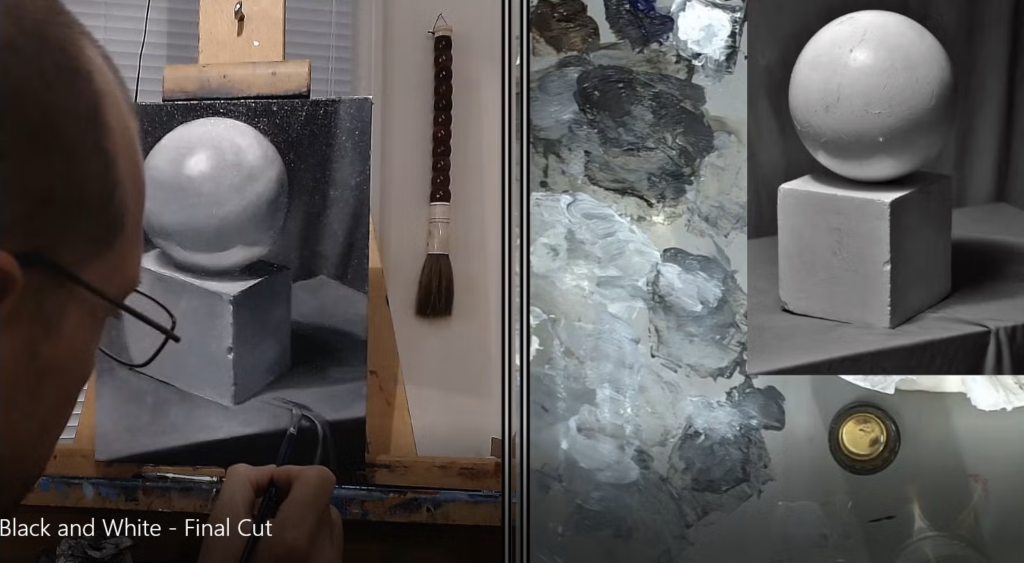
Zoom Black and White Demonstration

Melissa Gonzalez, Collage Painting Project
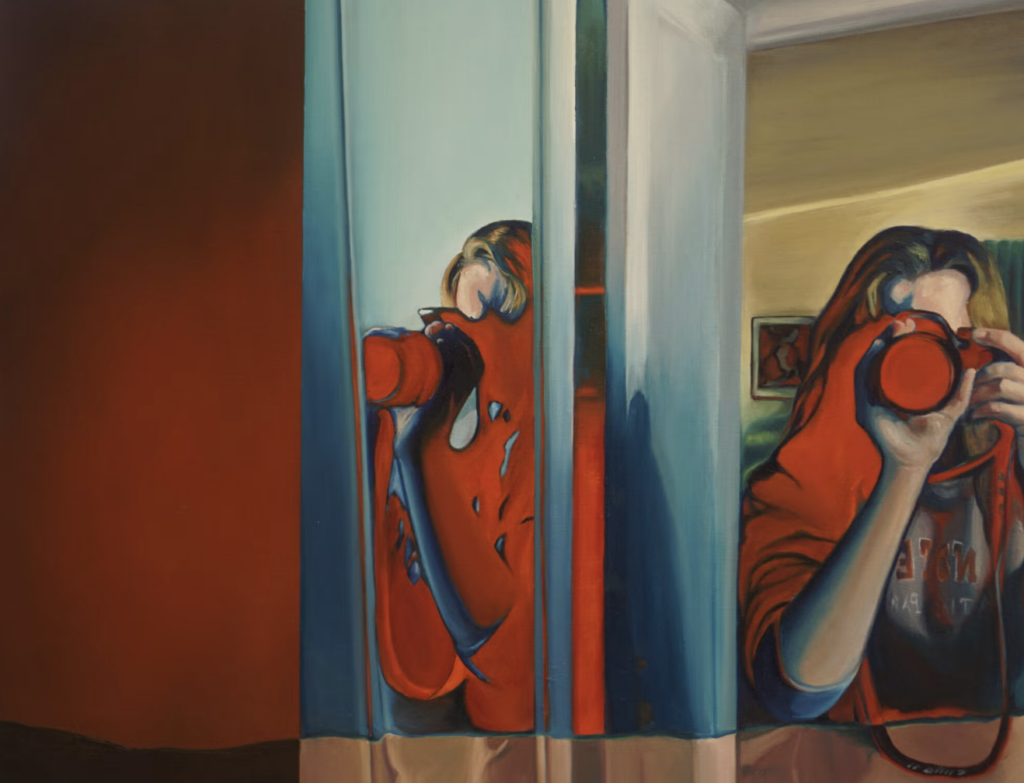
Susanna Hermann, Multiplicity Painting Project
ARTS 1500-02 – Painting I: Oil This is an introductory painting course that teaches the basic techniques of painting. Students learn to paint from observation, in a manner that results in a realistic depiction of the subject. However, the goal of this course is not to make copies, but to strike a balance between an art historical approach to painting with a contemporary one – fostering an environment that encourages students to think creatively and to experiment with the paint and the subject. This is achieved through live demonstrations, artist slide lectures, group, and individual critiques.
This course is taught by Professor Scott Hutchison.
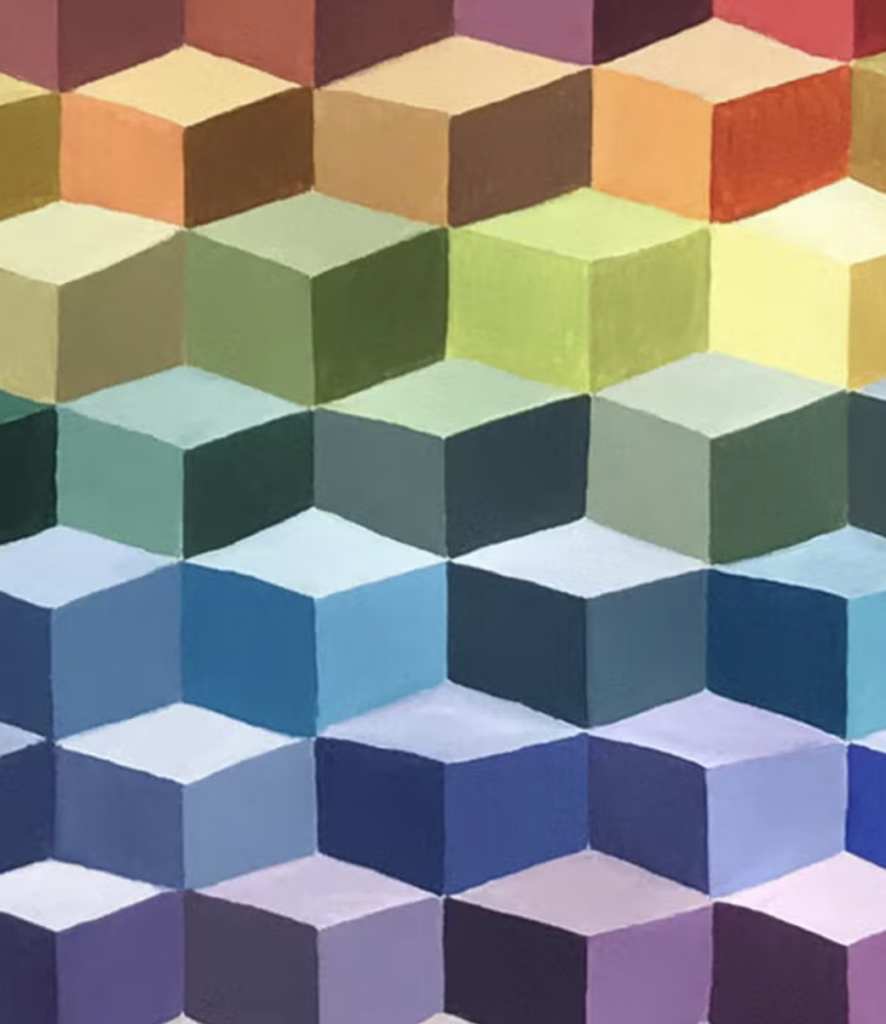
Julia Tolfa, Oil on canvas.
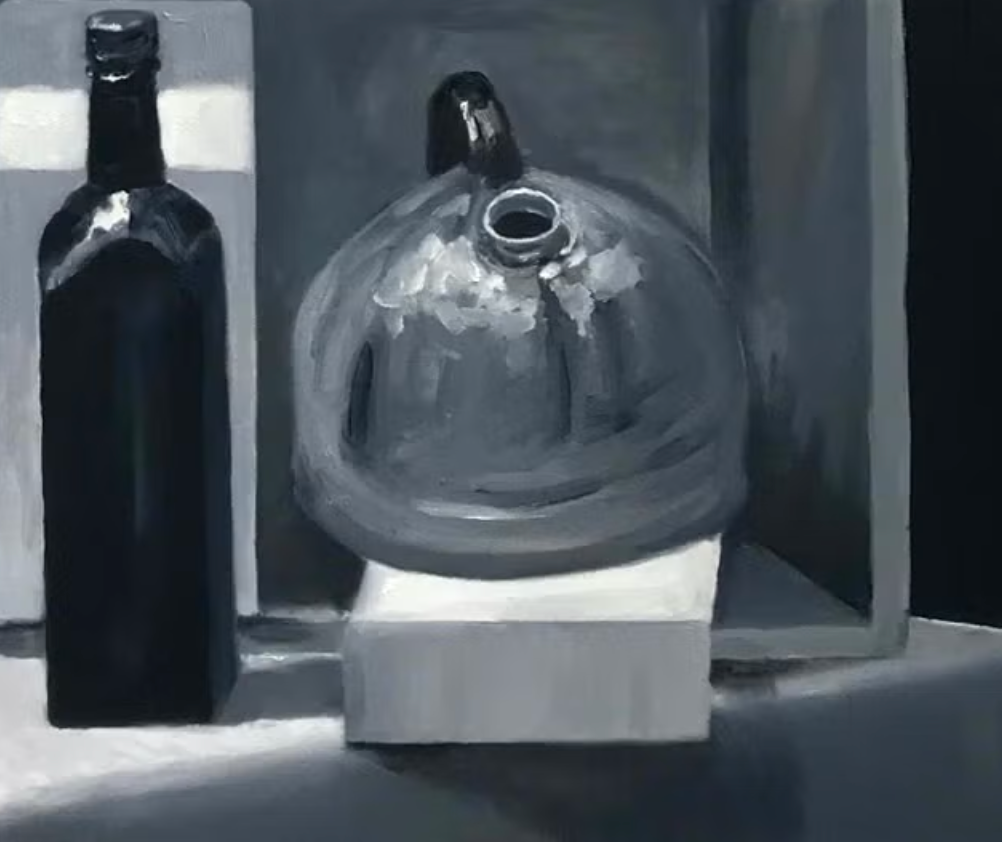
Ethan Clark, Oil on canvas.
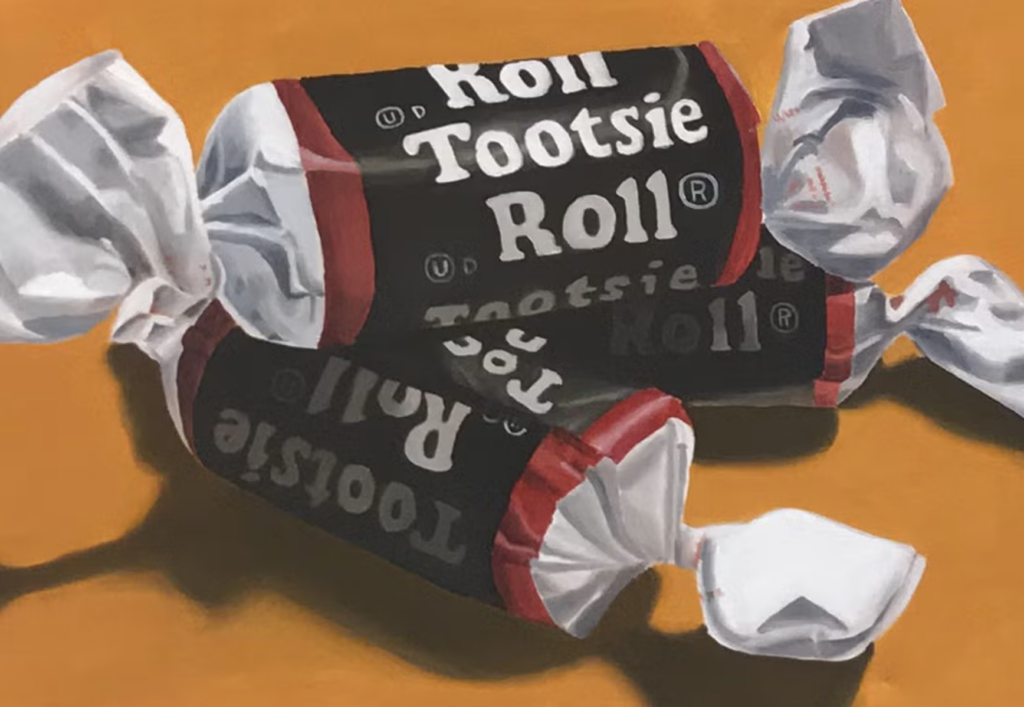
Julia Tolfa, Oil on canvas.
ARTS 1500-03 – Painting I: Oil, is a studio art class developing the techniques and concepts of painting in traditional, oil medium used from the Renaissance to today. Students will learn the basic techniques of transparent glazing and opaque oil painting. They will investigate the impact of color and value on the illusion of space and form. While focusing on the traditional subjects of landscape, still life, and figure, they will create a portfolio of three paintings developing their drawing and painting abilities with the medium. Studio demonstrations, lectures, slide presentations and individual and class critiques will be conducted online using Zoom and Canvas to present all aspects of instruction. Students create oil paintings during regular class sessions with feedback from the instructor. They continue to develop their paintings outside of class. The students receive individual guidance and evaluations from the instructor during each class as well as valuable insights from the student discussions during class critiques.
This course is taught by Professor Ann Schlesinger.

Project 3: Fruit with multiple colors

Allemai Dagnatgchew, Project 4: Self-portrait
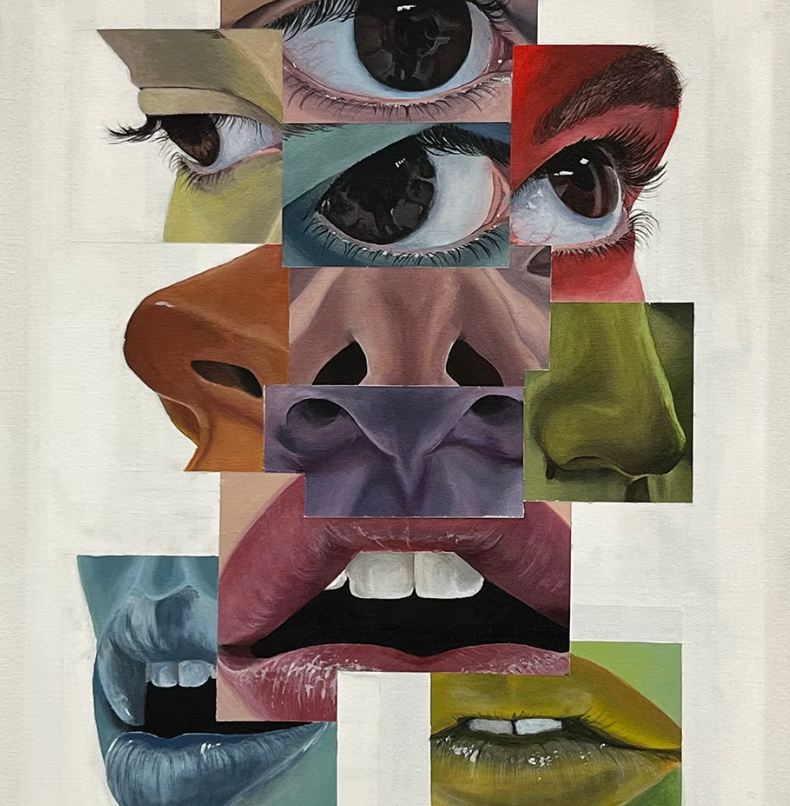
Cristina Macaya, Fragmented Self
ARTS 1501-01 – Painting I: Acrylic This is an introductory course that consists of lectures and studio labs. This course focuses on both the acquisition of fundamental knowledge of acrylic painting, and the creation of paintings using one’s own unique imagery. Relevant art historical references and resources will be introduced in order for students to contextualize their work in reference to art history. Students will utilize critical thinking and problem-solving skills by doing progressively challenging assignments. As they work on these assignments throughout the semester, they will develop a more sophisticated aesthetic approach in the areas of color, composition, perspective, balance, and subject matter. There will be five class critiques (four critiques for each individual assignment and the last final critique for the entire course) throughout the semester and each student will have opportunities to discuss their work as well as the work of others.
This course is taught by Professor BG Muhn.

Edson Martinez, Watercolor on paper.

Danielle Deiotte, Watercolor on paper.
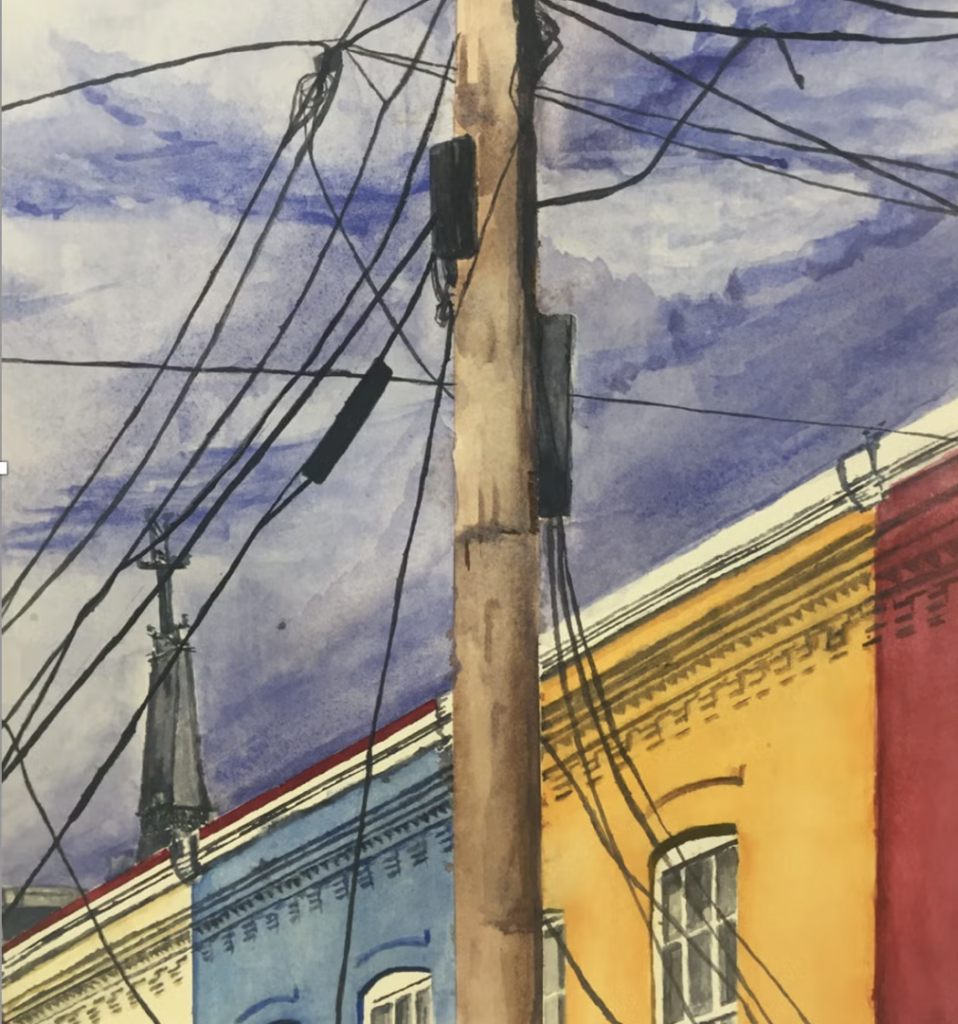
Jack Wathieu, Watercolor on paper.
ARTS 1502-01 — Painting I: WatercolorThis is a studio art class focused on developing the techniques and concepts of painting in traditional, water-based medium. Students will learn the basic techniques of transparent and opaque watercolor. They will investigate the impact of color and value on the illusion of space and form. While focusing on the traditional subjects of landscape, still life, and figure, they will create a portfolio of five images developing their drawing and painting abilities with the medium. Studio projects (watercolors), demonstrations, lectures, and; individual and class critiques will be conducted online using Zoom and Canvas to present all aspects of instruction — technique demonstrations, slide presentations and class discussion. Students create watercolors during regular class sessions for one-on-one feedback from the instructor and they continue to develop their paintings outside of class. The students receive individual guidance and evaluations from the instructor during each class as well as valuable insights from the student discussions during class critiques.
This course is taught by Professor Ann Schlesinger.
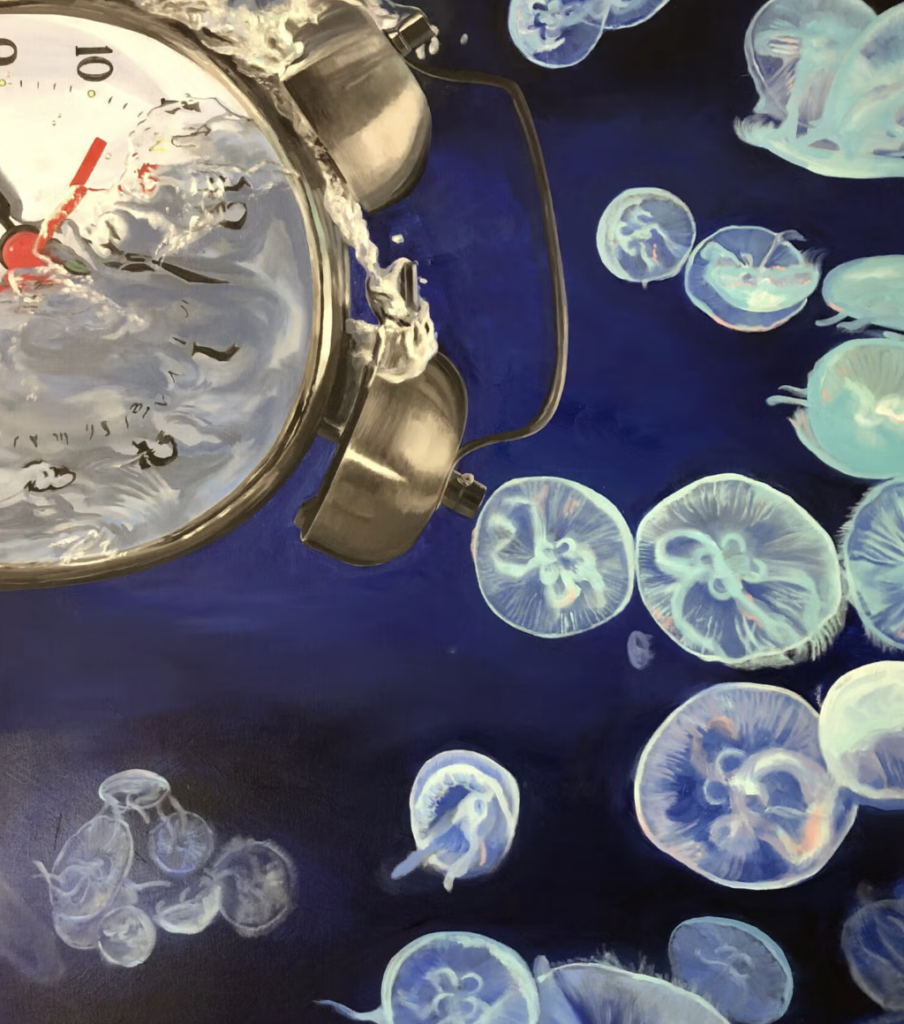
Jude An, Project 1: Conceptual Container

Christina Shoucair, Project 1: Conceptual Container
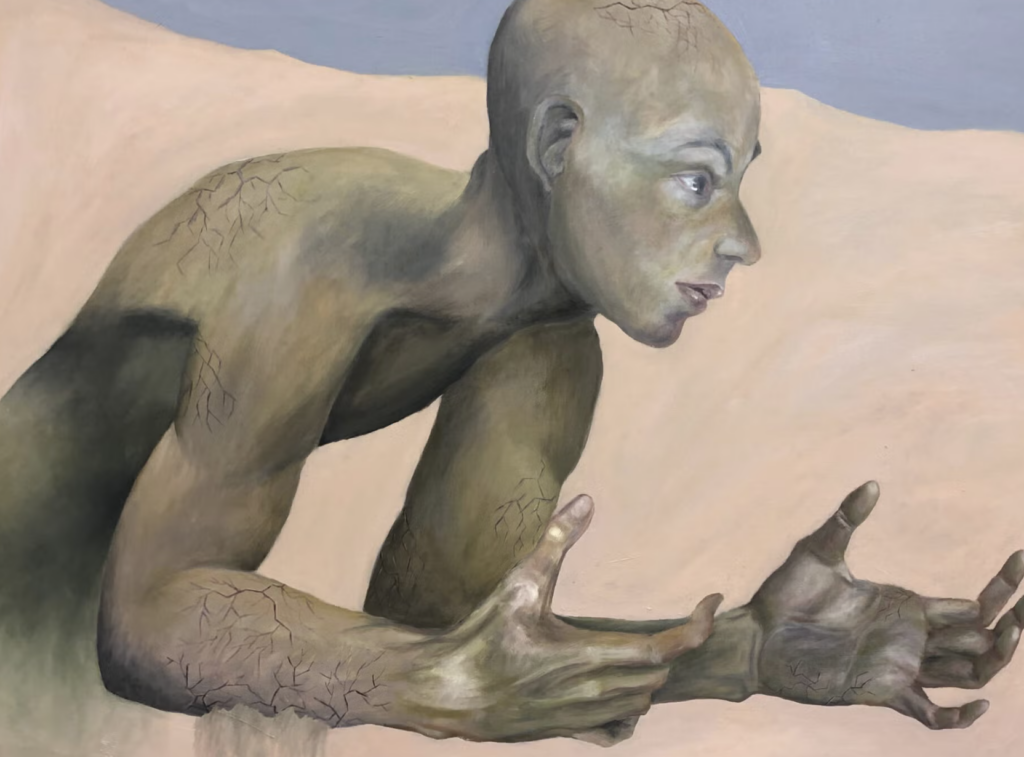
Sharon Huynh, Project 2: Human Body
ARTS 2500-01 — Painting II: This is an intermediate-level painting course. The overall theme of the assignments for the semester is moving away from straight observational painting and exploring imagination and visual dynamism within a juxtaposition of the real and the unreal, blurring the boundaries between dream and reality and consciousness and the subconscious. This will be the overarching idea for all three projects while each project deals with a specific subject matter. Relevant references and resources will be introduced for students to contextualize their work using art history. Assignments begun in class will require time outside of class to develop and complete. Medium: either oil or acrylic.
This course is taught by Professor BG Muhn.

Camouflage Project: In Design I, we cover color mixing and color theory. In this project, by Elena Zheng, the students were asked to think about the idea of camouflage and how to integrate two or more natural or man made objects by thinking about their color placement and arrangement.
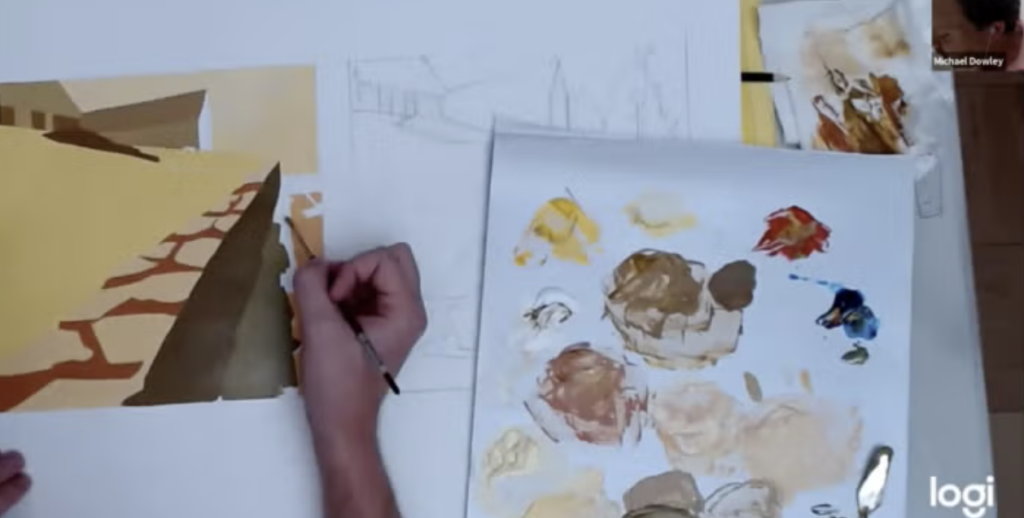
Experimental color compositions: In this project (seen here: Professor Dowley’s demonstration) students use their own photographs of architectural spaces to develop two simplified color compositions. One of the compositions is monochromatic (one primary color is chosen as a starting color) and the other is developed from complimentary colors.
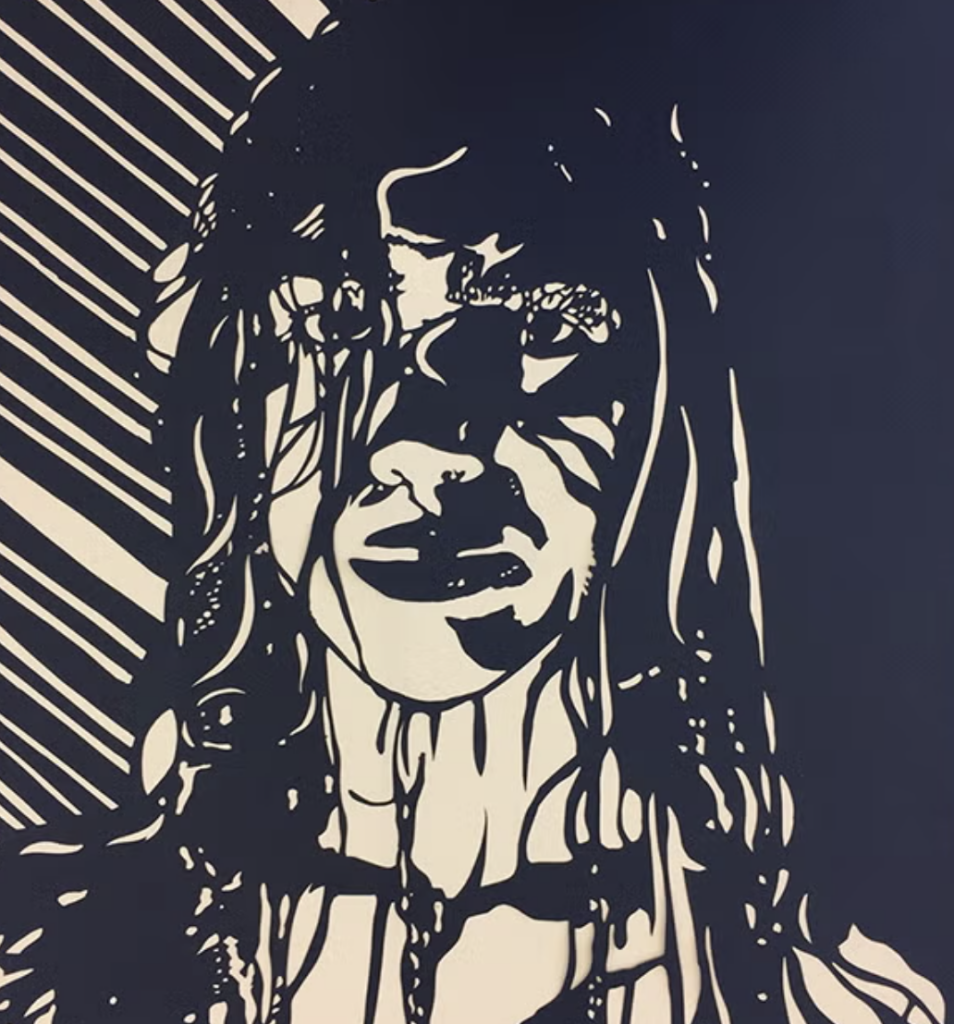
Paper Cutting: Students learn to cut intricate designs using only paper and X-acto knives. Students develop their images from their own photography and from drawings.(student work: Cornelia Thomas)
ARTS 1600-03 — Design I This is an introductory art studio course. Using drawing, painting, sculpture and photo materials, students learn the principles and elements of design necessary to communicate and express themselves visually. Special topics include collage and papercutting.
This course is taught by Professor Michael Dowley.

Alexandra Smalto, Paper Luminary Project

Angela Liu, Color Cube Project
Assignment covering Line and Plane Elements with Repetition and Difference Principles
ARTS 1600-04 – Design I Design I is an introductory art studio course. During the semester, we focus on the study of fundamental skills used for making visual art. This includes both conceptual and technical development. The broad goals of the course are to train our eye to understand and refine compositions as a way to communicate ideas visually. This section of Design will focus on creating three-dimensional forms using easy-to-manipulate materials such as paper, cardboard, foam-board, and wire. This course is required for all art majors and is recommended for art minors and as an elective for students interested in exploring the discipline of studio art.
This course is taught by Professor Evan Reed.
Dakota Access Pipeline protests, also called by the hashtag NoDAPL. Students had studied the bauhaus design and did research on the DAPL and created poster designs.
After learning the tools in illustrator and talking about branding and typography students design a logo, do variations and design business cards for the business and learn about the printing process. Work by Michelle Motta.
Students learn to do a portfolio newsletter in InDesign for their projects. This a spread from Nia Jordan’s portfolio.
ARTS 1602-01— Graphic Design I: Students will learn the formal, aesthetic, and communicative aspects of creating effective graphic images. Projects include logos, typography, and digital arts that promote mastery of techniques, methods, and materials. In order to foster creativity, we start with breathing meditation at the start of class, followed by discussions about design and learn the Adobe software and the foundation of design principles. The goal of this class is to strengthen students’ visual literacy and communication skills as part of their liberal arts education.
This course is taught by Professor Negar Nahidian.
Student multilingual print and interactive magazines based on chosen topic, major or minor
Chiara Lewis, translation drawings, pre-logo
Angela Perez, logo design and branding, laser etched and cut Maker Hub promo item
ARTS 1602-02 — Graphic Design I: This is a studio art class focused on the creation of graphic design assets for print and screen-based media. During this course, you will learn basic Adobe Illustrator, Adobe Photoshop, and Adobe InDesign software through real-world projects and current topics in graphic design. The course seeks to familiarize design students with the communicative power of visual form and to help students develop a personal process of creating original graphic forms capable of effectively communicating a message or information. Projects integrate the following topics: principles of graphic design, design research, logos and branding, album cover design, interactive and print publication design, typography, graphic design history, and professional portfolios.
This course is taught by Professor Toni-Lee Sangastiano.
Bauhaus Poster: Consume More Art, Create More Art. After studying the Bauhaus, students were asked to do a poster project based on the Bauhaus principals Design, typography and use of color. Top left: Shana Bottom, left: Kate Gregory Bottom, right: Andres Siles-Loayza, Top right: Edson Martinez
Happiness book: Students were asked to do the layout and design of a book and send it to print. They were asked to use Adobe illustrator and photoshop for the images and Adobe Indesign for the layout and typography. Work by Juliette Silvain.
Quarantine Cusine book: Each student was asked to share their one favorite recipe and to design and do the typography and layout of a spreading he book. Work by Anne-Isabelle de Bokay.
ARTS 2600-01 — Graphic Design II: Students will learn the mindful, formal, aesthetic and communicative aspects of creating effective graphic images. Typography, the history of type, type classifications and more will be taught and discussed. Students will design a book in Indesign and send to print, along with a type classification project cards, and other projects.
This course is taught by Professor Negar Nahidian.
Screengrab from film by student Sarema Shorr
Screengrab from film by student Renata Garcia
Screengrab from film by student Shana Shin
ARTS 1700-01 — Animation I: This course is designed to introduce students to basic methods and practices in animation while exposing them to artists working independently in the field. The course will provide an overview of techniques ranging from hand-drawn frame-by-frame animation, to object animation and pixelation. Each class will consist of a short demonstration, viewing of related works, hands-on experimentation, and critique. Weekly assignments will further students’ exploration of animation approaches and techniques. The course will conclude with the creation of final projects in which students will develop and create an animated short in a medium of their choosing.
This course is taught by Professor Elyse Kelly.
Screengrab from film by student Sarema Shorr
Screengrab from film by student Margaret Neely
Screengrab from film by student Shana Shin
ARTS 2700-01 — Animation II This class is an intermediate course that explores experimental and traditional animation practices through exercises using 2D digital techniques. Each week will consist of a lecture, a screening of related works, and a lab. By the end of this course students will be able to execute short animations, visually express both abstract concepts and conventional narratives, and identify how animation principles affect all animated work be it digital or analog, independent or commercial, refined or rough. Students are expected to play, take risks and work outside their comfort zones.
This course is taught by Professor Elyse Kelly.
ARTS courses at the 3000-4000 level are designed primarily for Art Majors, Minors and advanced students who want to work with a professor on one or several independent projects over the course of the semester. These courses require approval. Please inquire with the individual instructor for more information.
These courses include:
Kelly Latimore, Mama (2020), digital print reproduction of original painted icon (8.5 x 11 inches).
Sebastian Errazuriz, Crucifixion Popsicle (2012), Laser-engraved wood and Holy Wine (6.4 x 12.7 cm).
Tano Festa, The Creation of Man (1964; enamel and emulsified paper on wood, 190 x 272 cm; Rome, Franchetti Collection).
ARTH 1412-01 — Global Catholic Imagination Human imagination is one of the most powerful mental faculties, bringing together memory, intuition, the senses, and creativity. Artists have relied upon this to express abstract concepts – particularly those related to spiritual beliefs – in concrete, material forms. Using a broad lens, this course examines how a Catholic imagination is constructed through the visual arts by focusing on three major themes: the human condition, wisdom and knowledge, and the existence of God. This course allows students to explore Catholic social teaching (Life and Dignity of the Human Person, Call to Community, Rights and Responsibilities, the Poor and Vulnerable, Rights of Workers, Solidarity, and Environmental Stewardship) as it appears and is expressed in art across historical periods (Late Antique to Contemporary Art) and through a wide variety of media (painting, sculpture, textile, performance, video, and AI). Students are encouraged to incorporate viewpoints on class, race, ethnicity, gender, sexuality, globalization, and ecology into their awareness of how personal context influences artistic production.
This course is taught by Professor Tiffany Hunt
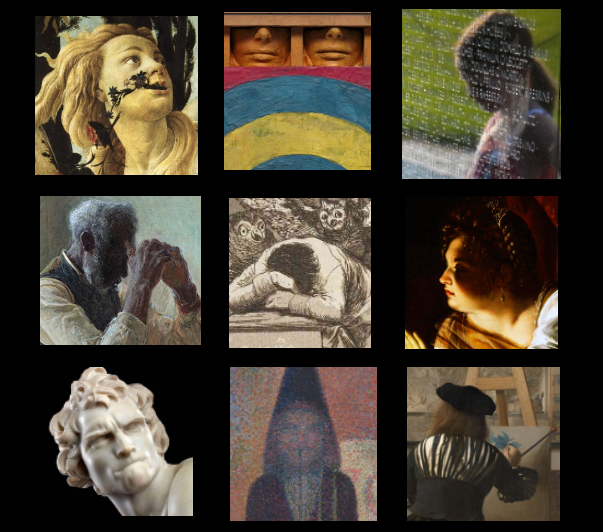
ARTH 1640-01 — Renaissance to Modern Art This course surveys major work and developments in European and American painting, sculpture, and (to a lesser extent) architecture from c. 1300 to the present. We focus on changing aims, means, and perceptions of art amid political, religious, social, economic, and other contexts. What have artists, patrons, institutions, and others wanted works of art to accomplish, and in what ways? We will schedule two class visits to the National Gallery of Art.
This course is taught by Professor Alfred Acres.

Delacroix, Liberty Leading the People, 1830
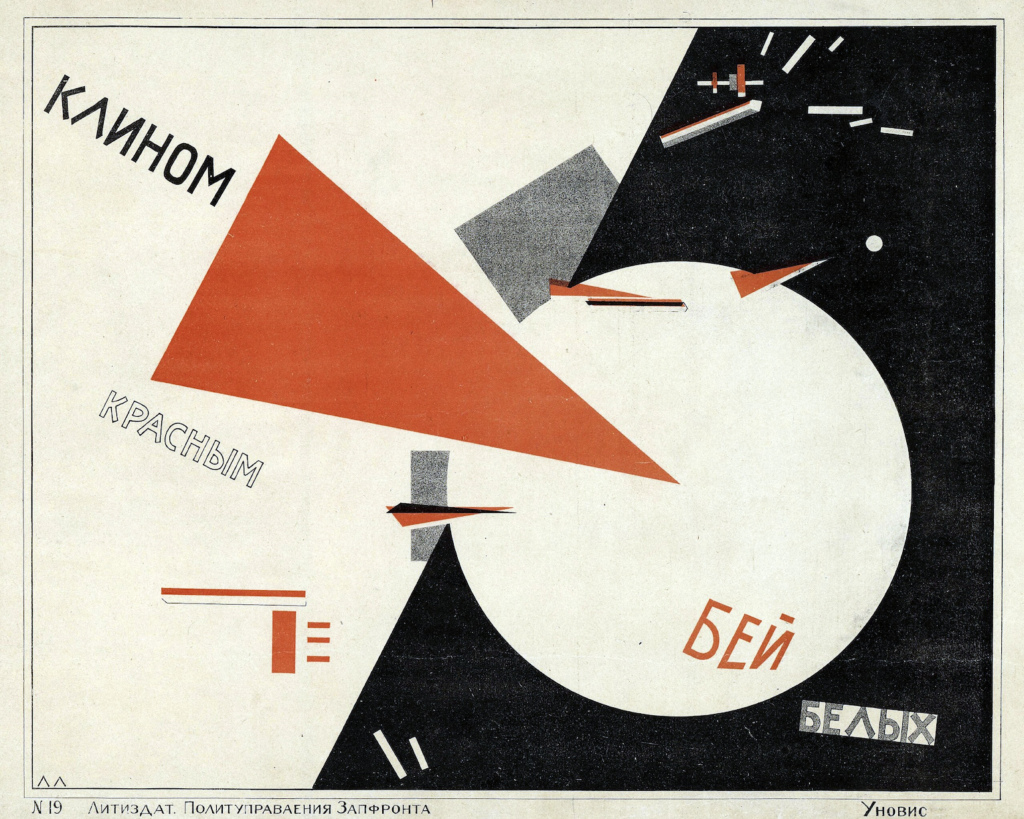
Lissitzky, Beat the Whites w/ the Red Wedge, 1919
ARTH 1841-01 — Art/Revolution in Europe This course examines European art in relation to the study of events of political revolution and violence from 1789 to 1924. From the hard-edged paintings of Neo-Classicism that came of age during the French Revolution, to the abstractions of Constructivism that gave form to the Bolshevik cause in Russia, the admixture of radical politics and avant-garde aesthetics has always defined the course of modern art. What, then, is the relationship between politics and art, particularly during dramatic events of social and political upheaval? How does radical art correspond to radical politics, and what are the limits of each when considered as separate, or even as together? What role does violence play in the production of revolutionary images? With these questions in mind, students will learn how the study of art can illuminate how these past revolts, rebellions, and insurrections that happened across Europe and its colonial territories continue to shape geopolitics and art today.
This course is taught by Professor Jacob Lewis.
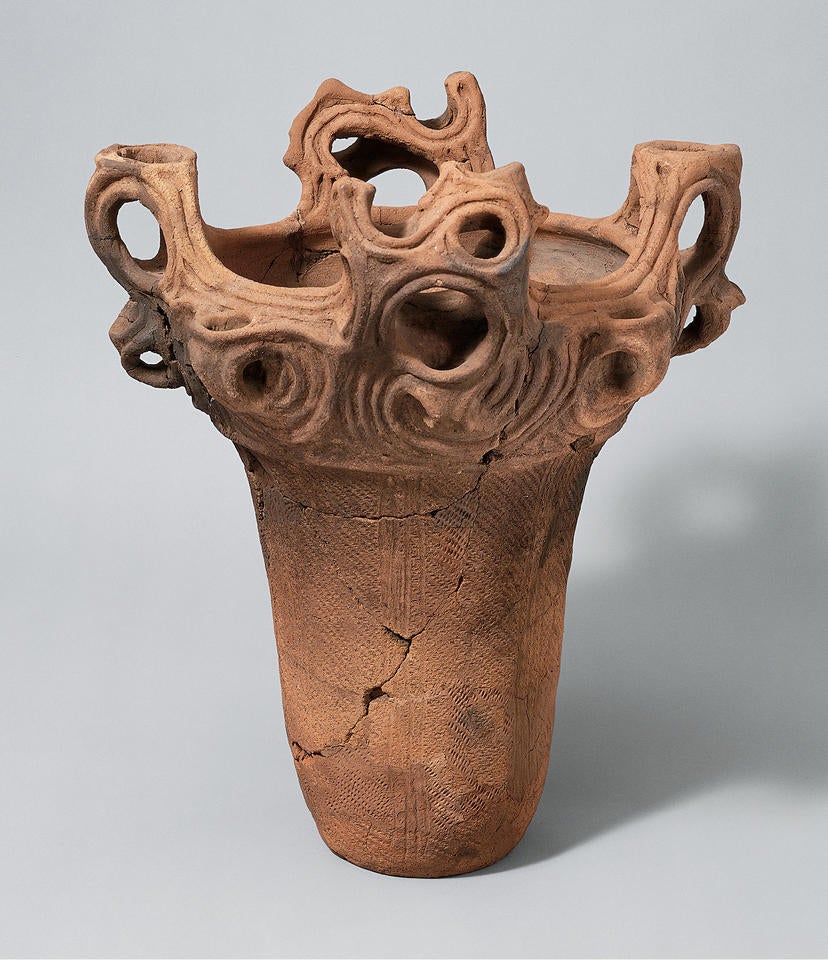
“Flame-Rimmed” Cooking Vessel, Jomon period (ca. 10,500 BCE-ca. 300 BCE), Metropolitan Museum of Art, Mary Griggs Burke Collection, Gift of the Mary and Jackson Burke Foundation, 2015, 2015.300.258

Great Buddha Hall, Todaiji, originally built Nara period (710-794), present structure Edo period (1603-1868)

Katsushika Hokusai (1760-1849), Minobu River, from the series “Thirty-six Views of Mt. Fuji,” Edo period (1603-1868), ink and color on paper, National Museum of Asian Art, F1974.60
ARTH 2121-01 — Arts of Japan This course examines Japanese art from the prehistoric period to the 20th century. We will focus on Shinto shrines, Buddhist monasteries, narrative handscrolls, decorative folding screens, objects associated with the tea ceremony, woodblock prints of the “floating world,” and oil paintings. Emphasis will be placed upon the interrelationship between the visual properties of art objects and their materials and techniques, as well as the historical, social, and cultural contexts of their production. The issues that we will explore include interregional contacts and artistic exchange between the Japanese archipelago and the Asian continent, the functions of objects within religious contexts, the artistic patronage of members of the aristocracy and the military elite, and artistic encounters between Japan and Europe. Class visits and assignments focusing upon the collections of the National Museum of Asian Art will complement classroom learning and teach students how to engage with original artworks. No prior knowledge of Asian art is required or assumed for this course.
This course is taught by Professor Michelle Wang.
Claude Cahun, Self Portrait, 1928
William Eggleston, The Red Ceiling, 1973
ARTH 2180-01 — History of Photography This course introduces key methods, terms, and themes in the history of photography, charting a path from its origins in nineteenth-century European art, science, and industry, to the myriad artistic and cultural adaptations of digital photographic media in the global present. As an object of study, photography’s attraction is that there remains no aspect of modern life – from birth to death, from sex to war, from atoms to galaxies, from the cheapest commerce to the most valuable art works – that is not touched by it in one way or another. Photography is a class of images and a practice that thoroughly infiltrates and mediates the world around us. This ubiquity, or everywhere-ness, poses a unique problem for history, theory, and practice: how do we develop a coherent method of analysis for something so spread across (modern) time and space? How can we speak with equal sensitivity about the photograph as a product of optics, chemistry, software, and hardware, as well as what it claims to represent with such exacting fidelity? How can we identify the meaning of a photograph when that meaning is so heavily determined by its specific context, its movement through information cultures, as well as its use in social rites and rituals? Throughout the course, we will address these questions through a close study of photography’s history in relation to social and material conditions from 1839 to the present. To this end, you will be actively engaged in looking closely at images, in addition to reading scholarship, commentary, and criticism related to our most abundant technical image: the photograph.
This course is taught by Professor Jacob Lewis.

Pueblo Shield, c. 1850. National Museum of the American Indian.

Georgia O’Keeffe. My Front Yard, Summer, 1941. © Georgia O’Keeffe Museum.

Ed Ruscha, Dodgers Stadium, 1000 Elysian Park Ave. 1967.
ARTH 2762-01 — Myths of the American West This is the first in a series of Georgetown Dialogue Initiative course team-taught by two Art History professors and exploring fault lines in American identity through the history of culture and its preservation/display. This semester’s focus on ideas of “the West,” does several things: it is a survey of Western American art over two centuries, suitable for those with no art history background; it critically explores ideas of Americanness; and it provides a discussion-oriented space for conversation and reflection around challenging topics. Themes include: Indigenous American art, “cowboy” painting, colonial/postcolonial narratives, the emergence of photography, kitsch and tourist art, Los Angeles and San Francisco as cultural/financial hubs, fascinations with the Southwest and Earthworks, and the rise of a west coast artworld.
This course is taught by Professors Lisa Strong and Ian Bourland.
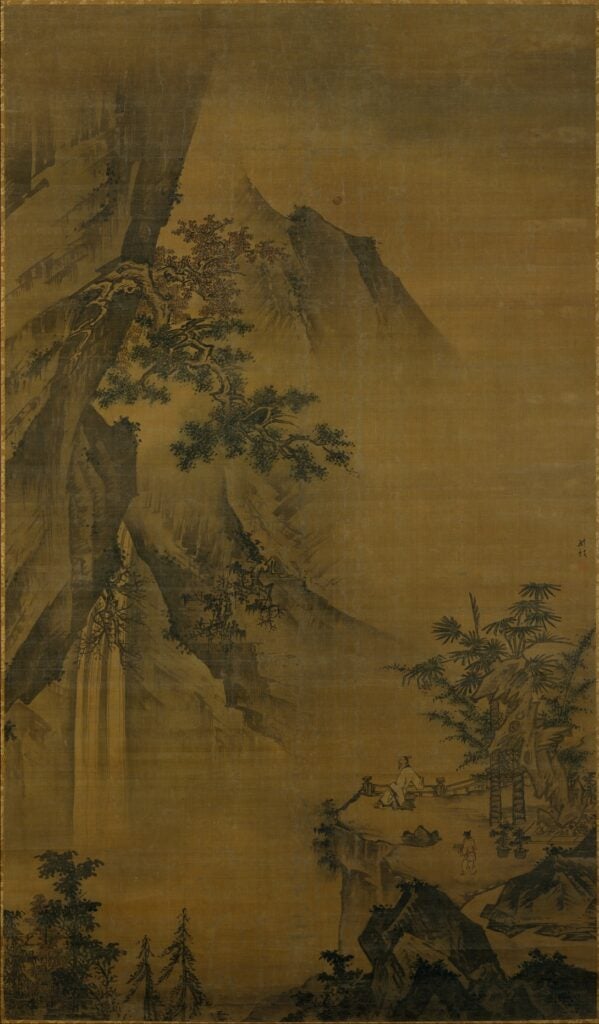
Zhong Li, Scholar Gazing at a Waterfall, late 15th century, hanging scroll, ink and color on silk. New York, The Metropolitan Museum of Art, n. 1991.438.4
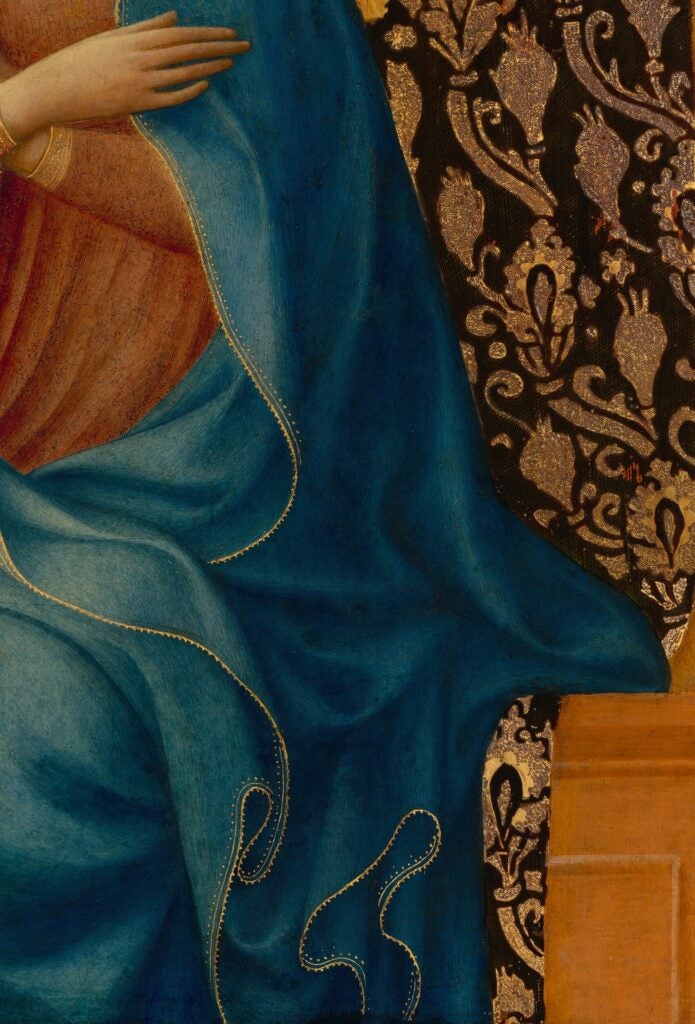
Masolino da Panicale, The Virgin Annunciate (detail), c. 1430, egg tempera and tooled gold on poplar panel. Washington DC, National Gallery of Art, n. 1939.1.226
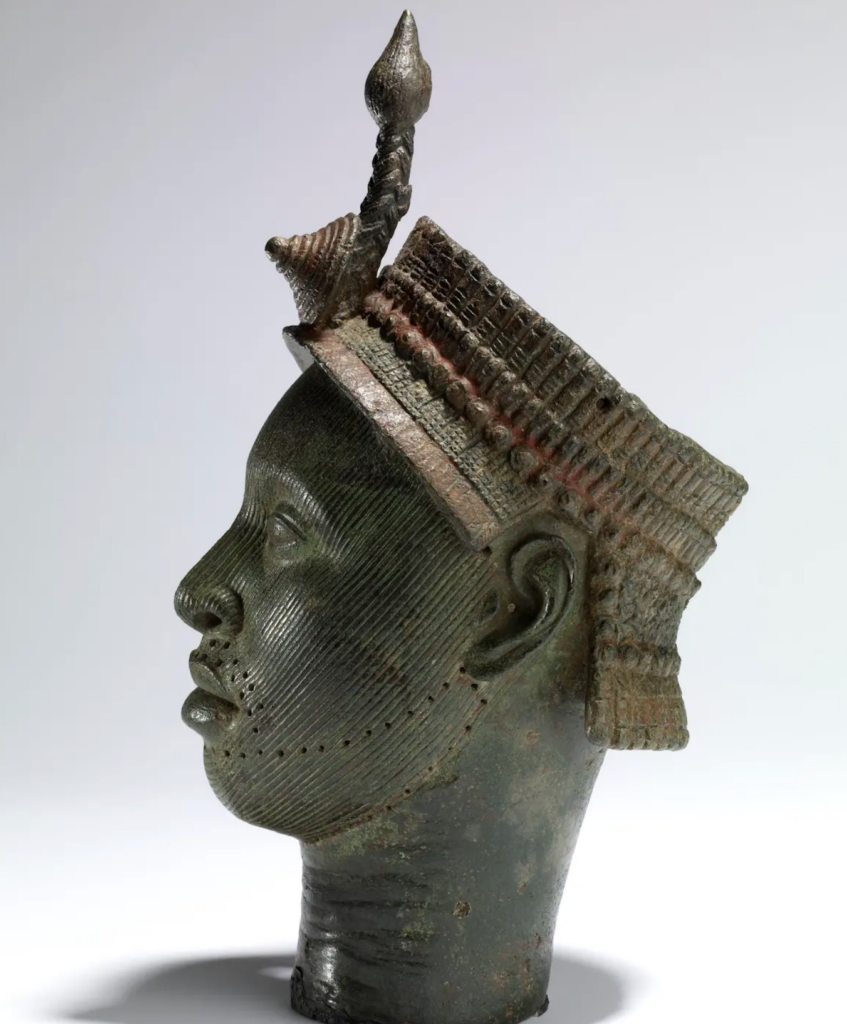
Ife Head, brass, 14th-15th Century (probably). London, British Museum, n. Af1939,34.1
ARTH 3541-01 — The Intelligence of Matter This course focuses on the materials, techniques, and processes of early modern art-making across the globe. Through the lens of materiality, students will develop critical tools to illuminate aspects of material culture, engagement with (and/or exploitation of) the natural environment, and global trade embedded in the physicality of the art objects. Each week will center on a specific material (ink, terracotta, wood, oil painting, bronze, paper, lapis lazuli, gold, silk, and so on), but recurring themes will weave through our discussions. These include the ways in which early-modern global exchanges progressively integrated ecological systems and supply chains; the impact of social structures and economic forces on the organization of labor within artistic workshops; the reconsideration of art-making as a form of applied knowledge informed by processes of creative thinking, technical refinement, risk-taking, problem-solving, and trial-and-error learning; and the interplay between human and non-human agencies (the artist’s body and skills in relation to the affordance of matter). Throughout the course, students will gain a historiographic overview of the “material turn” in Art History and engage with critical tools from other fields that have proved central to this methodological reorientation—in particular anthropology, technical art history, ecocriticism, postcolonial studies, and feminist theory. Although the course focuses on the arts of the early-modern period, it is open to interested students from all disciplines. Participants will be encouraged to explore materiality within the context of their own subfields and to pursue research topics aligned to their individual interests and academic goals. Please note: Graduate students should register for section ARTH 5541-01.
This course is taught by Professor Gabri Matarazzo.
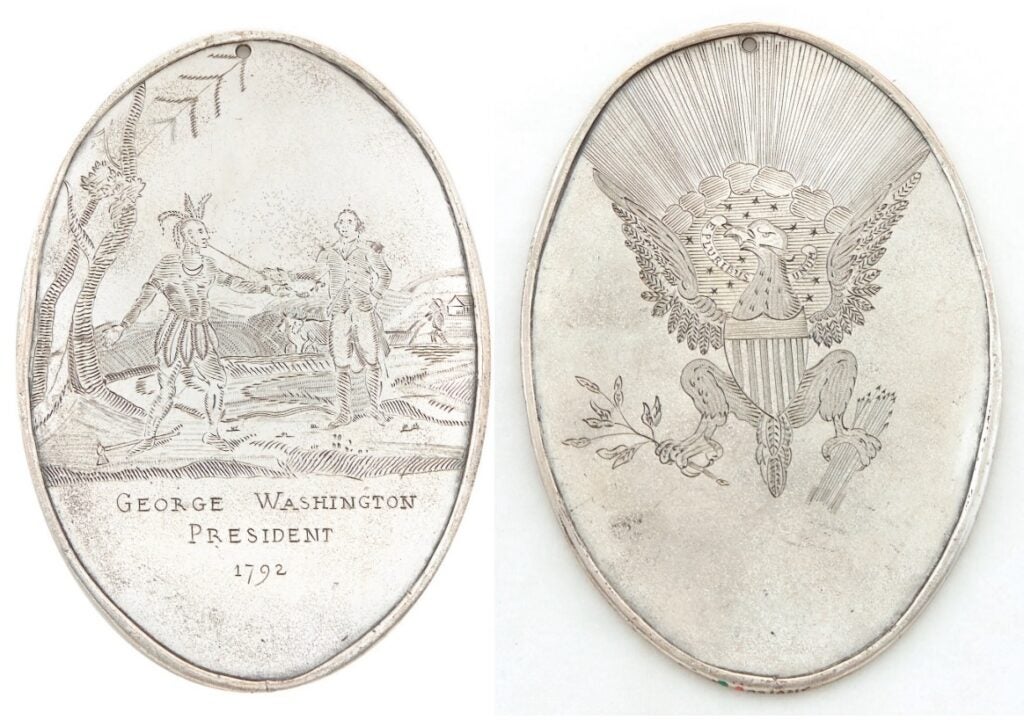
Indian Peace Medal given by President George Washington in 1792

Alexandre Hogue, Drouth Survivors, 1936, Oil on canvas
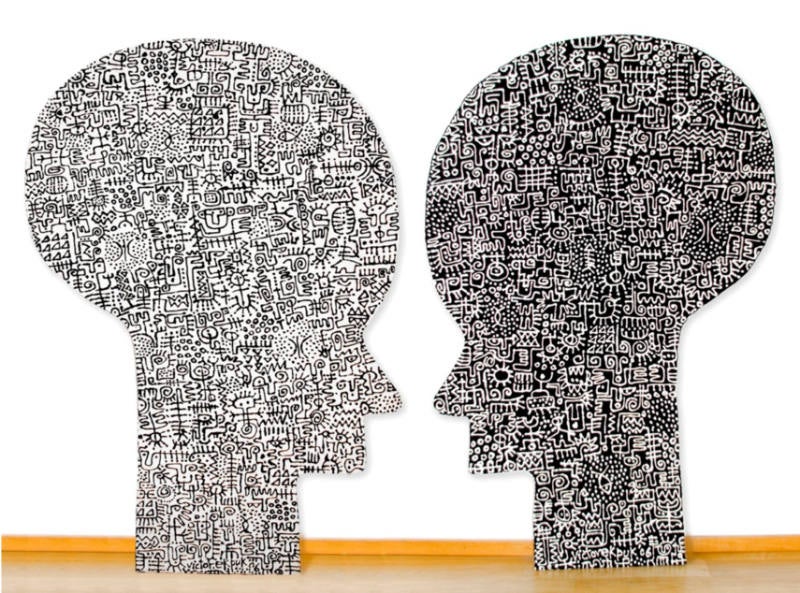
Victor Ekpuk, I Be You You Be Me, acrylic on wood, 2007
ARTH 3813-01 — Art and Diplomacy This course examines the evolution of art as a form of soft power in diplomatic relations, tracing its development from the “cabinets of curiosities” of sixteenth-century Europe to the complex, competing agendas involved in deploying art today. It provides an overview of the historical evolution of diplomacy through the “close looking” of artworks. Through a series of case studies from various countries, we will explore contemporary understandings of the stakes involved in the purchasing, gifting, and displaying of objects between nations and communities. We will investigate the social and political implications that accompany these evolving relationships. The class will analyze the intersections of materiality, economic and cultural value, display, and forms of nationalism, examining how art carries, retains, and conveys power among diplomatic brokers. While engaging in global discussions, the focus will be on American foreign policy. Please note: Graduate students should register for section ARTH 5813-01.
This course is taught by Professor Caroline Riley.
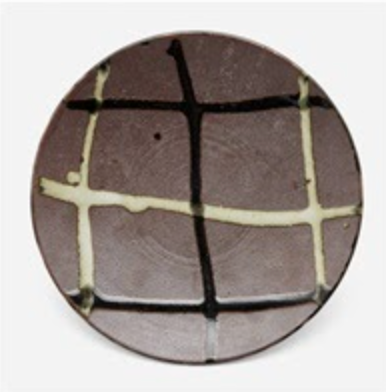
Shoji Hamada (1894-1978), Dish, 1955, dry iron-glazed stoneware with nuka and tenmoku glazes

Lockwood Kipling (1837-1911) and Bhai Ram Singh (1858-1916), “peacock-in-pride” overmantel for the Durbar Hall at Osborne House, Isle of Wight, 1890-92
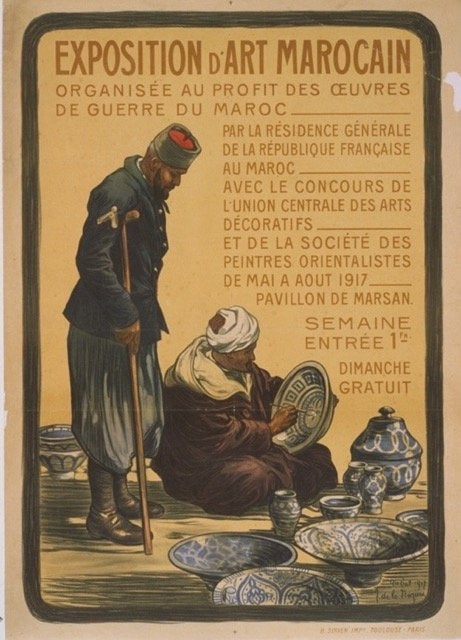
Exhibition poster for the Exposition des Arts Marocains, Pavillon de Marsan, Paris, May-August 1917
ARTH 4124-01 — Global Arts and Crafts The Arts and Crafts movement, which valorized the work of craftspeople and decorative artists over that of painters and sculptors, is generally associated with figures such as John Ruskin and William Morris, when it emerged in late 19th century Britain as a response to the machine-made ethos of the Industrial Revolution. However, it had an equally profound effect on other world regions as well. This course will examine the global impact of the Arts and Crafts movement by focusing on case studies in China, Japan, South Asia, and the Islamic world. We will consider how the goals and aims of the Arts and Crafts movement and its institutions were transformed and instrumentalized in colonial, semi-colonial, and post-colonial environments, inflected by questions of political ideology, cultural identity, and a growing sense of national self-determination. We will also examine how the traditional arts of these regions, in turn, infused Arts and Crafts thinking in Britain and Europe.
This course is taught by Professor Michelle Wang.
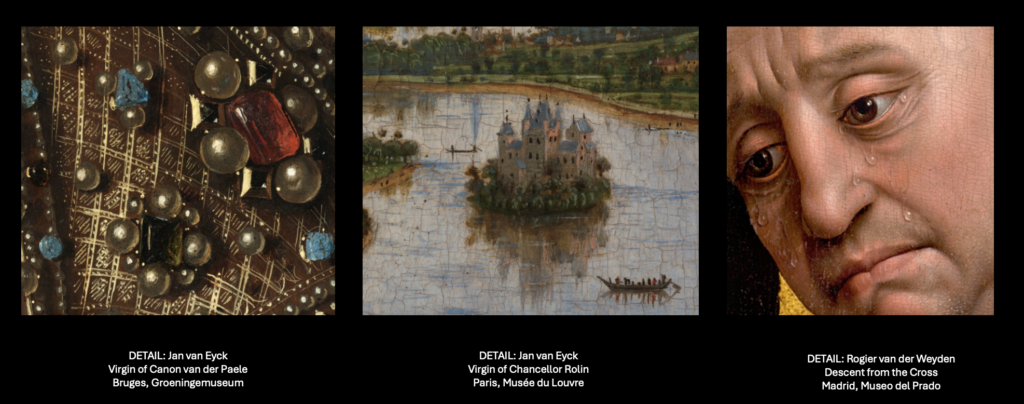
ARTH 4543-01 — Age of Van Eyck; Reality Remade This seminar explores one of the most pivotal episodes in European art history: the rise of radically new forms of realism in the early Renaissance. Our central figure will be Jan van Eyck, who developed a style, technique, and artistic identity unlike any others in the Western tradition. We will also consider the work of contemporaries working in the same region (the Netherlands) and related developments elsewhere in Europe. Why did painting change so rapidly in this period? What can this art—which includes many of the most obsessively studied works in all of art history—illuminate about our own 2024 assumptions (and blind spots) about the very idea of realism and its uses? Our topics will include the rise of the Artist as a singular individual in society, the evolution of independent portraiture, new economies of patronage and collecting, practices of artistic production, new conceptions of subject matter and symbolism, modern technologies for the study of old paintings, twenty-first century afterlives of Renaissance art, and more. What can “old masters” and their art mean and do for us today? One or two of our sessions will meet in the National Gallery of Art. No special knowledge of Van Eyck or Renaissance art is required. Prerequisite: at least one course in Art History at Georgetown or permission of instructor.
This course is taught by Professor Alfred Acres.

W.J. Blaeu, “Nova totius terrarium orbis geographica ac hydrographica tabula”, 1633
ARTH 4610-01 — The Global Baroque The term “Baroque” was first used to describe and disparage the style of art that emerged in Rome from the late sixteenth to the eighteenth century. Driven by global exploration, trade, colonialism and religious proselytizing, the characteristics commonly associated with the Baroque – such as formal dynamism, theatricality and fascination with the natural world- spread thorough Europe, the Americas, and Asia. This course will explore what is often regarded as the first global style of art. We will examine artistic developments in Italy before investigating how and where the baroque was mobilized, adapted and transformed in the contexts of the indigenous traditions. In addition to preparing for each class meeting, students will lead discussions and produce and present a final research paper.
This course is taught by Professor Barrett Tilney.

ARTH 4952-01 — ProtestArte The seminar explores the relationship between art and protest in Latin America and specific areas of the United States. Central to this exploration is examining how artists utilize art to articulate their social, economic, and political experiences while advocating for civil rights and cultural empowerment. Employing an interdisciplinary approach, the course considers various artistic movements, mediums, and techniques in historical and contemporary contexts. By studying the art of the Taller de Gráfica Popular, Mexican Muralism, Chicana/o/x, and Photojournalism, among others, students discern how artists employ art to instigate social and political critique, resistance, and activism. The seminar highlights art as a vehicle for amplifying marginalized voices, advancing social justice, instigating societal change, and understanding the impact of art within its cultural and historical settings, thereby serving as a catalyst for activism. The course integrates a critical analysis of visual art, performance art, street art, and alternative forms of creative expression to enhance our comprehension of the intricate relationship between art, protest, activism, and social transformation.
This course is taught by Professor Andrea Gallelli Huezo.
ARTH 4950-01 — Museum Fieldwork: Directed Study Students must have 9 credits in Art History and the advisor’s approval required. Only art history Junior and Senior majors or minor students.
This course is taught by Professor Ian Bourland.
ARTH 4998, Senior Thesis: By arrangement with a faculty adviser, majors may write a senior thesis on an art historical topic of their choosing. The thesis is optional but can serve as a capstone course that prepares students for future professional or graduate work.
These sections are taught by Professors Ian Bourland and Lisa Strong.
The Secretary of The InterIor’s Standards for Rehabilitation & Illustrated Guidelines on Sustainability for Rehabilitating Historic Buildings, 2011. A green roof on the top of the Department of the Interior, Washington, DC.
The International Council of Museums definition of Sustainability from the Dictionary of Museology, 2023.
AMUS 5209-01 — Climate Action in Museums Seen as some of the most trusted institutions in American public life, museums are uniquely positioned to facilitate public discussion of the environment and climate change with an opportunity to protect and strengthen these institutions. Surveying the evolution of sustainability in museums over the last fifteen years, this course examines the practical aspects of collections care, interpretation and public programming, operational changes, building construction, and community engagement to examine how changes in museum work can deepen museums’ connections to their communities and increase their charitable value. Students discuss and share ideas frequently in class, developing graded projects with feedback from classmates and the instructor. Topics include human behavior (the challenge of change, in daily practice or major projects, and how museums are well-suited to support staff, visitors, and communities in making change); mitigation (why/how museums and communities are reducing their negative effects on the environment, the climate, and to social and financial stability); and resilience (why and how museums are creatively helping their communities become more environmentally, financially, and socially adaptable in the face of a changing climate and increased impacts from weather events; how museums can share with the public the scientific and social discoveries enabling widespread change).
This course is taught by Professor Jerry Foust.
Fundraising Elements
Types of Fundraising
AMUS 5210-01 — Museum Development This course will focus on demystifying fundraising in a museum environment. We will cover the fundamentals of fundraising including building a case for support, moving a donor or potential donor from engagement to giving, making the ask for support, and stewarding donors. Additionally, we will examine the varied fundraising needs in museums, categories of donors that give to museums, diverse motivations for giving, and fundraising ethics. The course will feature projects, readings, and guest lectures that address how to effectively pitch fundraising projects, collaborate with other museum departments, and build long-term support for key initiatives.
This course is taught by Professor Nia Davis.

An Art and Museum Studies student installs her exhibition at Booth Family Special Collections, Georgetown University
AMUS 7952-01 — Spring Internship Museum internships provide concentrated practical experience within selected museum departments as well as an overview of the operations of a museum. Some of our internships include a staff-directed seminar; most involve a linked research project as well as an internship journal. Expectations and placement will be discussed during the orientation session. Schedule determined by student and museum supervisor; 15–20 hours/wk. Art and Museum Studies students only.
This course is taught by Professor Lisa Strong.